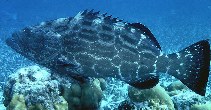| Family: |
Epinephelidae (Groupers) |
| Max. size: |
150 cm TL (male/unsexed); max.weight: 100 kg |
| Environment: |
reef-associated; marine; depth range 60 - 250 m |
| Distribution: |
Western Atlantic: Bermuda and Massachusetts, USA to southern Brazil, including the southern Gulf of Mexico and the Caribbean. Adults are unknown from the northeastern coast of the USA. |
| Diagnosis: |
Dorsal spines (total): 11-11; Dorsal soft rays (total): 15-17; Anal spines: 3-3; Anal soft rays: 11-13. Distinguished by the following characteristics: Side body has rectangular dark gray blotches. Outer third of second dorsal, anal and caudal fins black. Edge of preopercle smooth, without pronounced lobe at angle; 17-24 total gill rakers (Ref. 26938); depth of body 3.3-3.5 times in SL; head length 2.5-2.8 times in SL; evenly rounded preopercle, without distinct notch or lobe at the angle; subequal sizes of anterior and posterior nostrils (Ref. 89707). |
| Biology: |
Minimum depth from Ref. 126840. A solitary species (Ref. 26340) inhabiting rocky and coral reefs (Ref. 9710). Adults feed primarily on fishes; juveniles mainly on crustaceans. Oviparous (Ref. 205). A protogynous hermaphrodite (Ref. 55367). Forms spawning aggregations (Ref. 55367). Common but difficult to approach (Ref. 9710). Marketed fresh and its flesh is of excellent quality. |
| IUCN Red List Status: |
Near Threatened (NT); Date assessed: 20 November 2016 (A4bd) Ref. (130435)
|
| Threat to humans: |
reports of ciguatera poisoning |
Source and more info: www.fishbase.org. For personal, classroom, and other internal use only. Not for publication.
